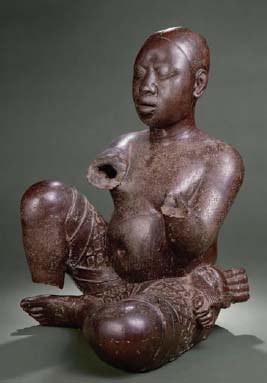The Medieval World, C. 400–1300Art of Medieval Africa |
What do the Yoruba consider beautiful? |
To make a beautiful work of art in the Yoruba tradition is a complex task with many aesthetic requirements and a long tradition of art criticism. The Yoruba are known for their multifaceted approach to beauty, in which morality of the artist affects the aesthetic value of the work they create. They value both the inner and exterior concept of self, and at the core of this value is the idea of iwa l’ewa, which means: character is beauty or, nature is beauty. The work of art itself, for example a figurative sculpture, must also possess specific qualities, including the following:
- Balance between realism and abstraction (for example, a sculpture should not be too real, nor too abstract)
- Clearly defined linear forms
- Smooth, delicate surfaces, and slightly rounded features
- Pleasing proportion and dignified symmetry
- Youthful liveliness balanced with calm maturity
An example of the Yoruba aesthetic can been seen in a thirteen-inch copper sculpture from the thirteenth to fourteenth centuries. This sculpture depicts a stoic, seated male figure, and though it is now damaged (the figure’s forearms are missing and there is some damage in the legs), the work displays skillful naturalism, individualized detail, smooth features, and appropriate size and proportion. It is possible that the seated figure was ritualistically adorned with the clothes and ornaments of a Yoruba leader and is associated with Yoruba themes of honor and respect. Yoruba society remains one of the largest in Africa, with a population of about thirty-five million in Nigeria alone, as well as other African countries, the Caribbean, and the United States. The Yoruba aesthetic continues to be an important element in Yoruba art production, and function, to this day.

The Yoruba people of Western Africa have a complex tradition of aesthetics.
